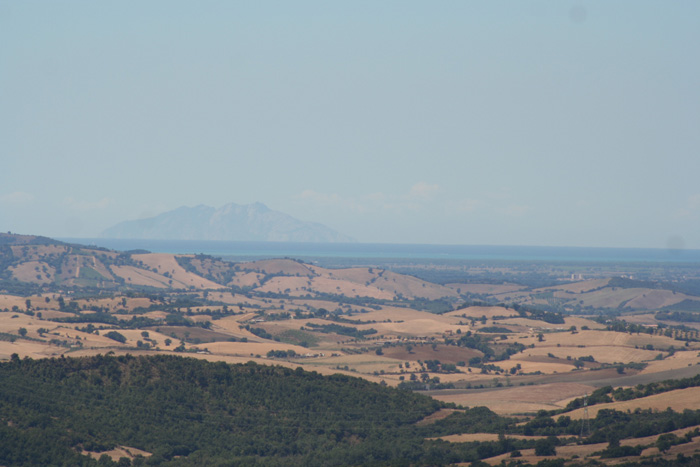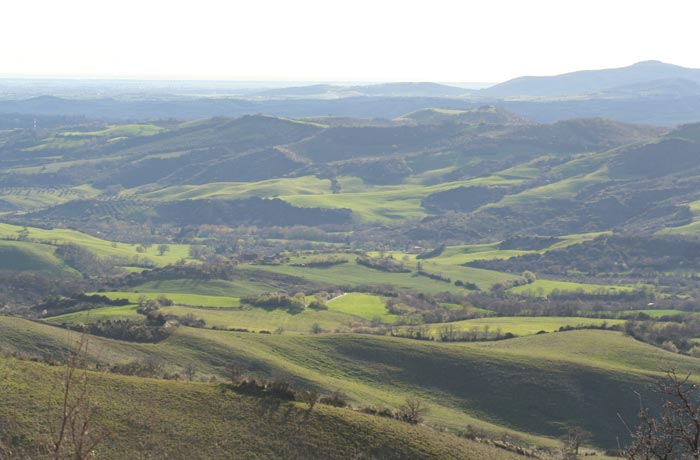The Maremma, the area of Tuscany which was once the heartland of the Etruscans
|
| The Maremma, the area of Tuscany which was once the heartland of the Etruscans stretches along the Southern Tuscan coast and inland to the hills of the Alta Maremma and the Tufo Area. After the Etruscan era, the coastal areas deteriorated into marshland and swamp, infested with malarial mosquito and inhabited only by charcoal burners, shepherds and cowboys, the "butteri". It was not until 1950 that the malarial mosquito was eliminated. As a result, this is one of the last unspoilt stretches of coastline in Italy. Traveling south from Grosseto you reach the Parco Naturale della Maremma. The Monte dell Uccelli, a long whale backed series of hills, form the backbone of the park. Old Spanish watchtowers dot these beautiful wooded hills, which, as their name suggests, are home to many resident, migrating and nesting birds. The forest-covered hills give way to grasslands, where the "butteri" tend their half-feral horses and white cattle, and to beautiful beaches. There is no public road to the park, which is reached by bus or canoe, on foot, bike or horseback from Alberese. Just outside the park you come to the ancient fishing village of Talamone, once an Etruscan town. The Sienese planned to make this sheltered harbor into a port that would rival that of Pisa, but clogging weed foiled the attempt. Leaving behind the Ucellini Park, the Via Aurelia Etrusca leads to the mouth of the Albegna River and to the Tombolo di Giannella, a sand spit which joins Monte Argentario, once an island, to the mainland. Another sandpit, or "tombolo", was also built up by the sea currents, to the south thus forming a lagoon, the Laguna di Ortobello, between the "island" and the mainland. The Romans constructed a causeway between the mainland and Ortobello on Argentario which divided the lagoon. The sheltered lagoons, only one metre in depth, draw hundreds of birds here, including rare species, and offer amazing bird watching opportunities. The scenery of the mountainous Monte Argentario, which reaches 635 metres at its highest point, Il Telegrapho, is dramatic, with headlands, bays and shingle beaches. Much of the area is still uninhabited and superb walking country. The main tourist centres are the ancient ports of San Stefano and Ercole. Three 16th century castles, remnants of the Spanish fortification of the Argentario, look down upon the yacht-filled harbor of the attractive little town of Porto Ercole.
|
 |
Podere Santa Pia, situated in a particularly scenic valley, which overlooks on the hills around Scansano, up to the Maremma seashore and Monte Christo |
Tuscan farmhouses | Podere Santa Pia |
||||
Once upon a time, Tuscany's Mount Argentario was an island. Now this rock is joined to the coast by way of three thin strips of land. Two of these, the Tombolo della Feniglia and the Tombolo della Giannella have formed naturally over the centuries, the other, the Orbetello lagoon dam (an artificial embankment serving as bridge) was constructed by man in 1840. Orbetello is a pleasant town of Tuscan Maremma, home to a number of noteworthy historic buildings. One of these is the Polveriera Guzman, edifice which now houses the town's Archaeological Museum. Then there is the renaissance style Palazzo del Podestà, the Gothic cathedral of Santa Maria Assunta, built on the ruins of an ancient Etruscan-Roman temple, and the Ciclopiche walls, erected in the 5th century B.C by the Etruscans.
|
||||



